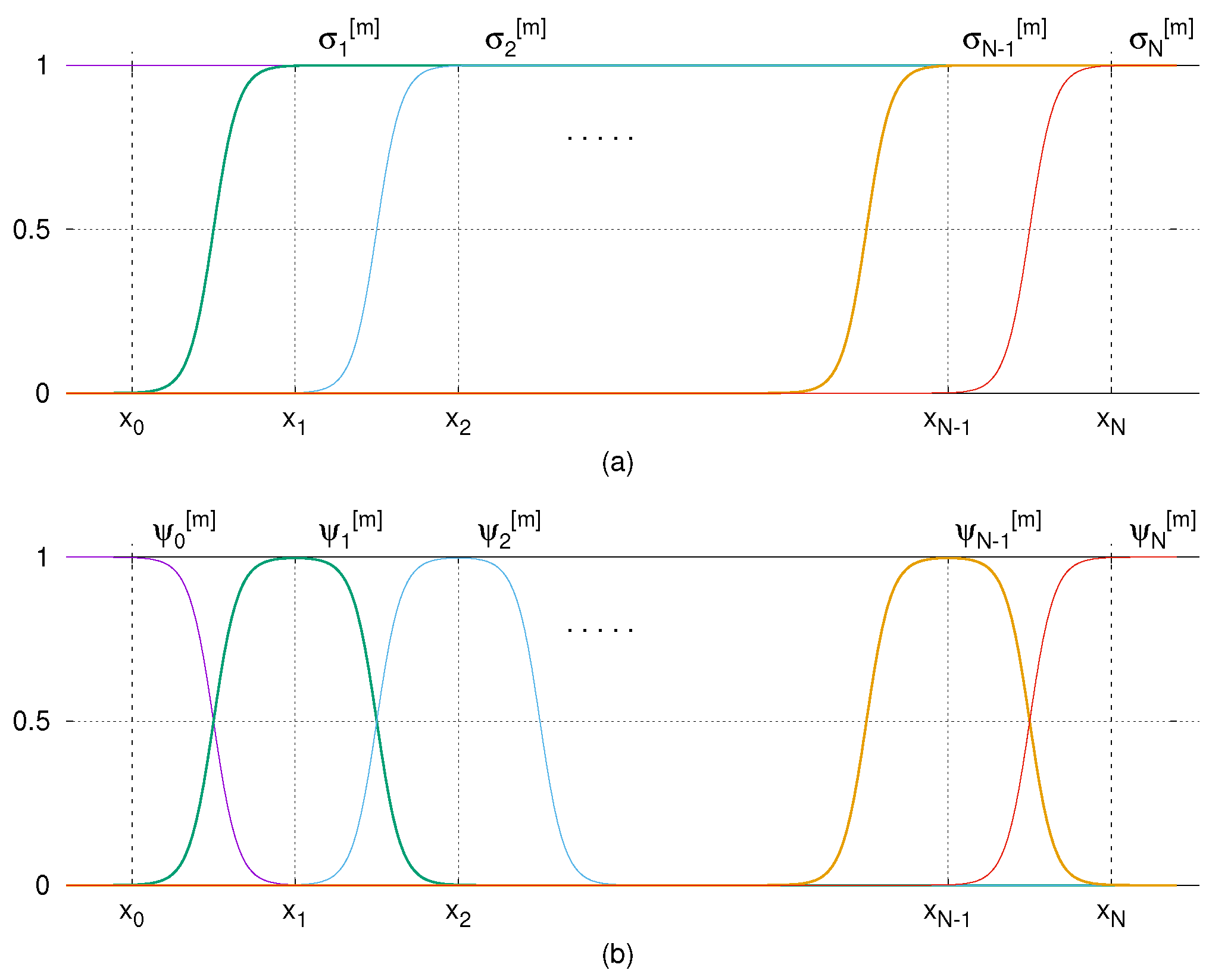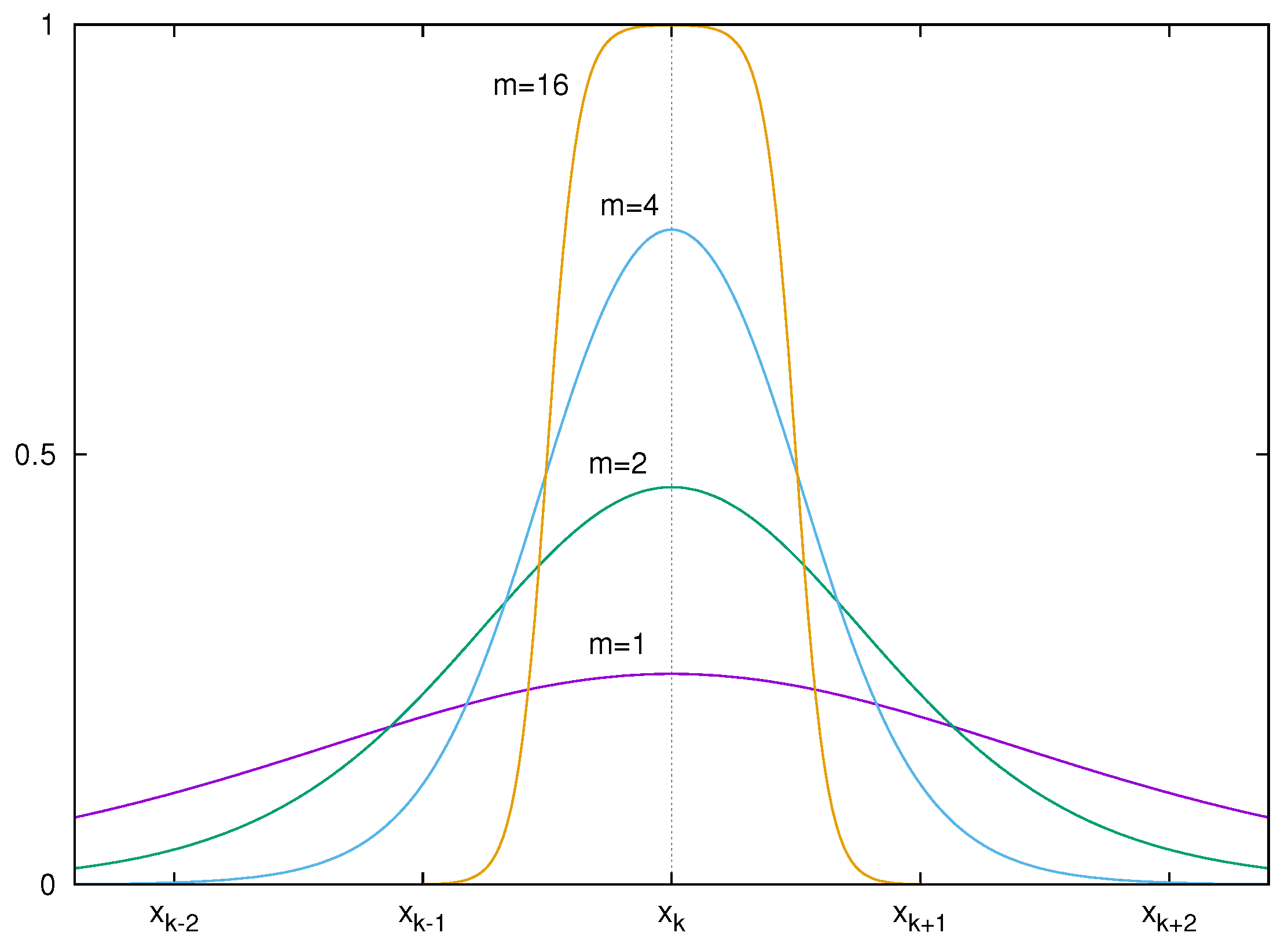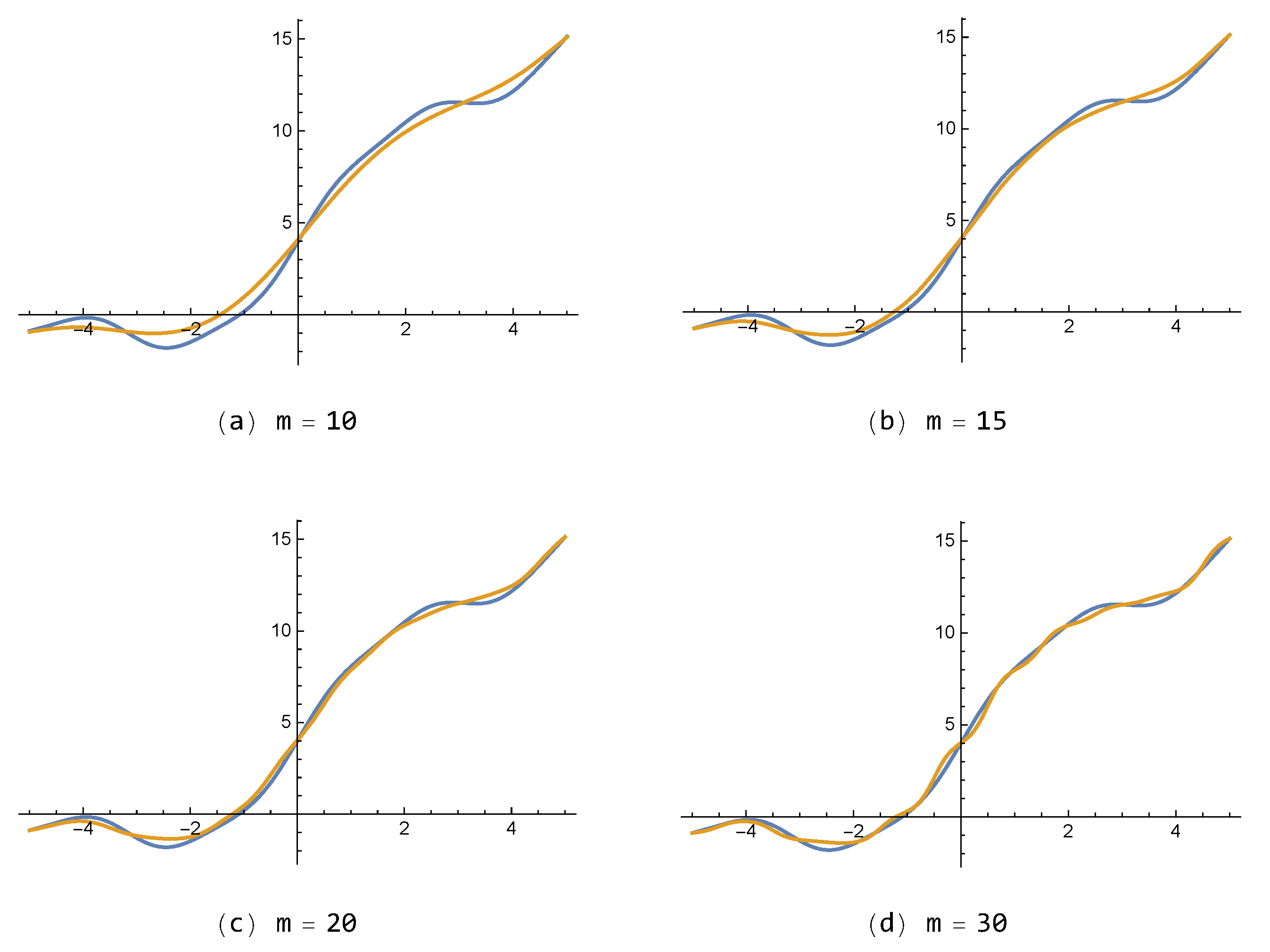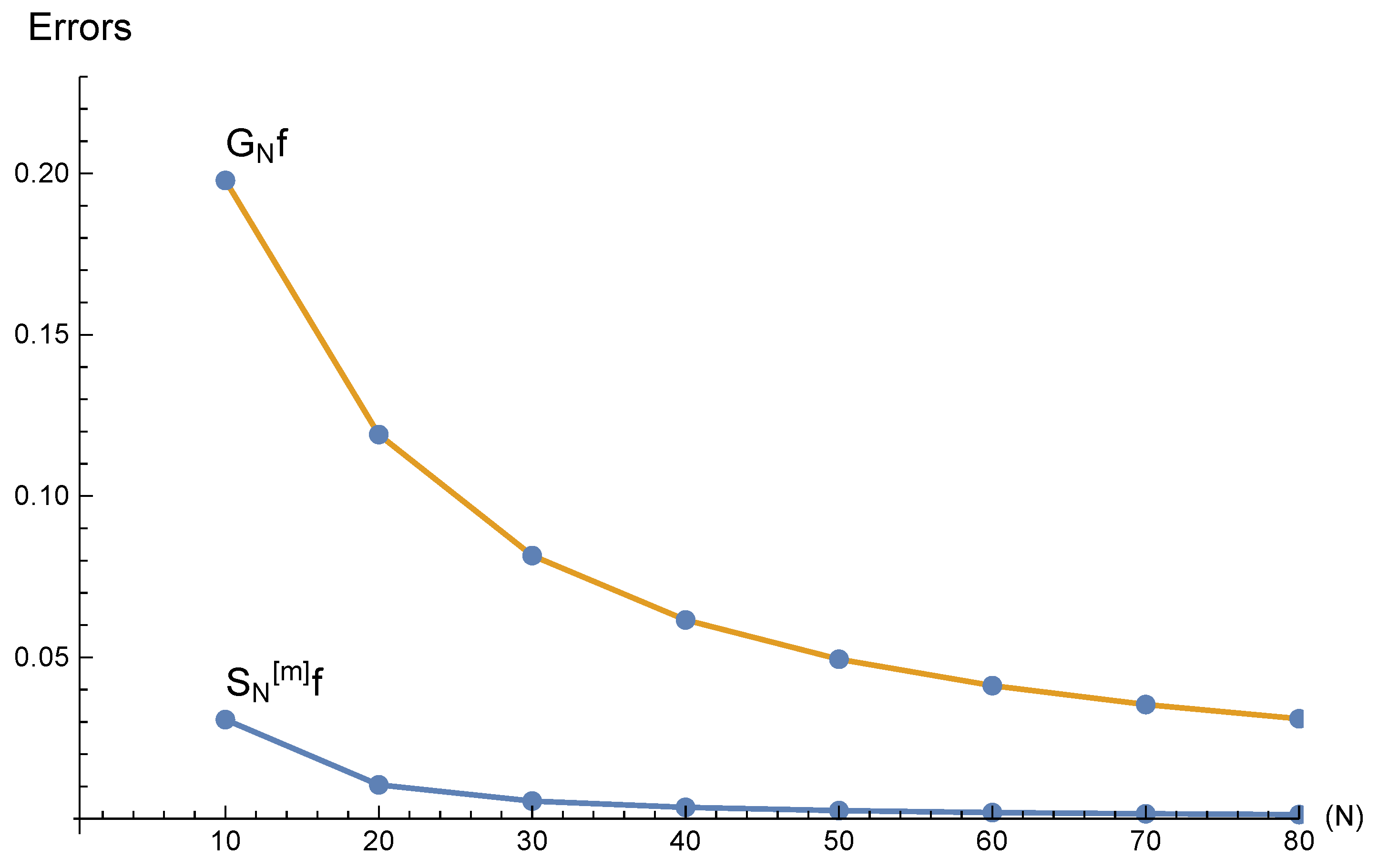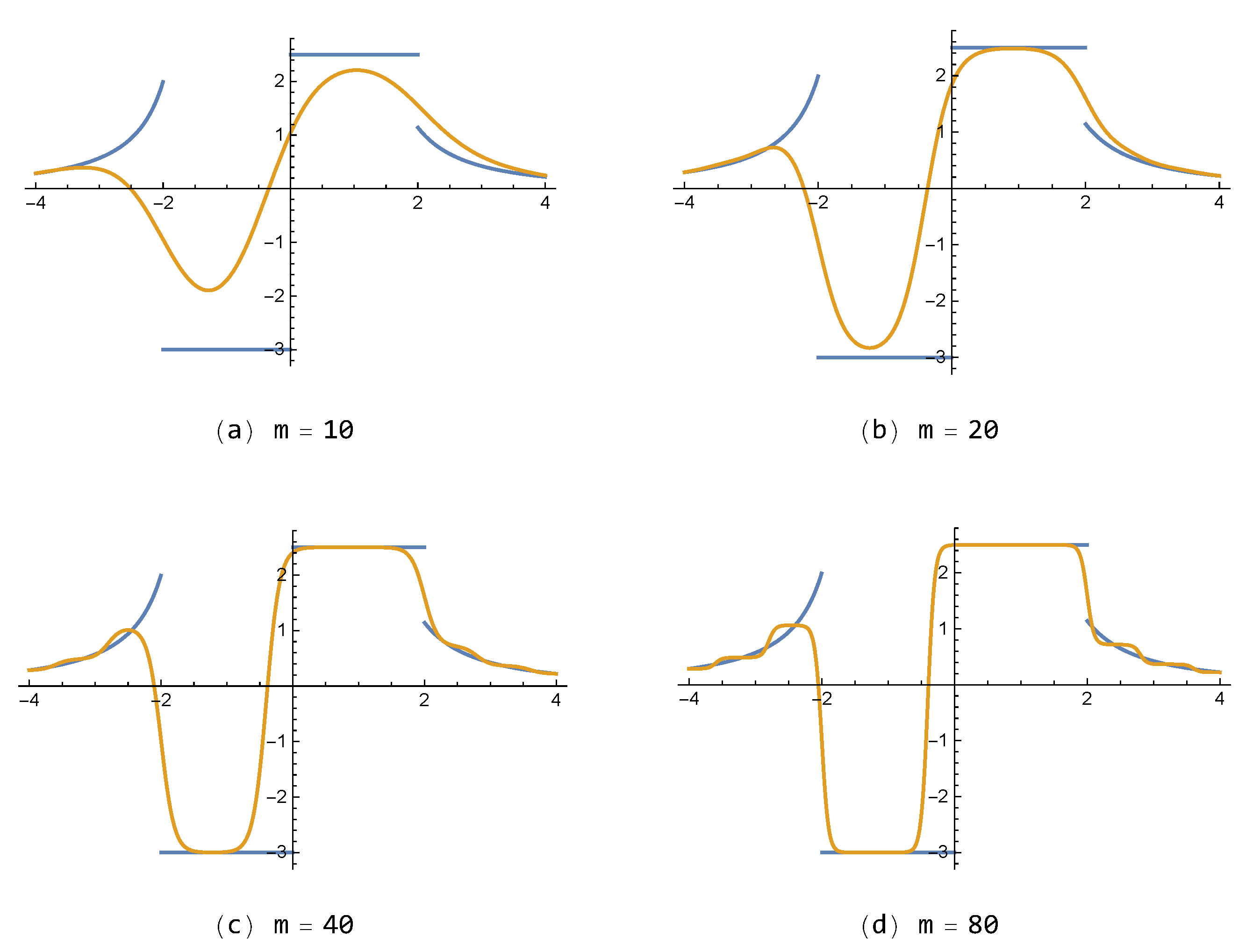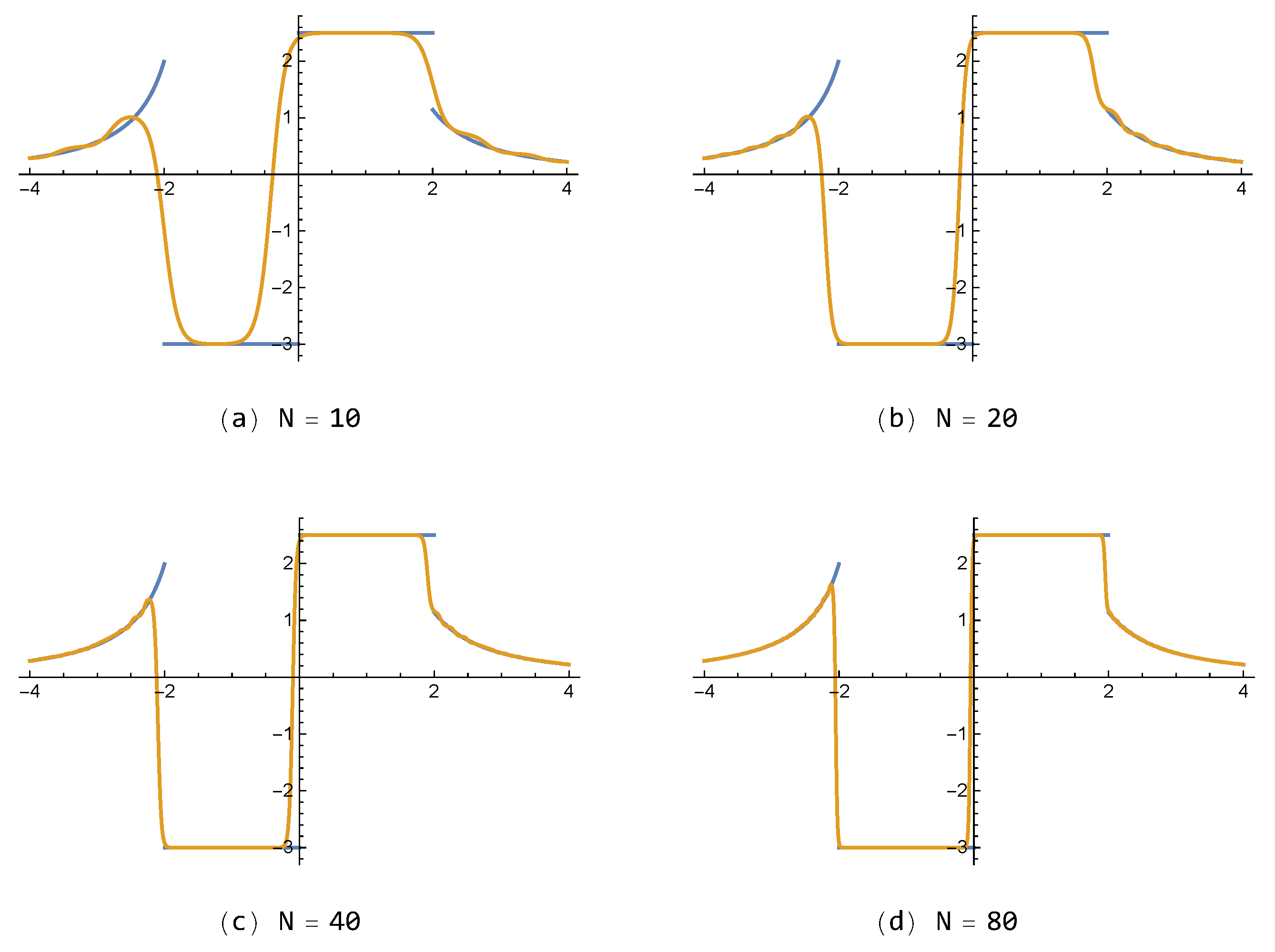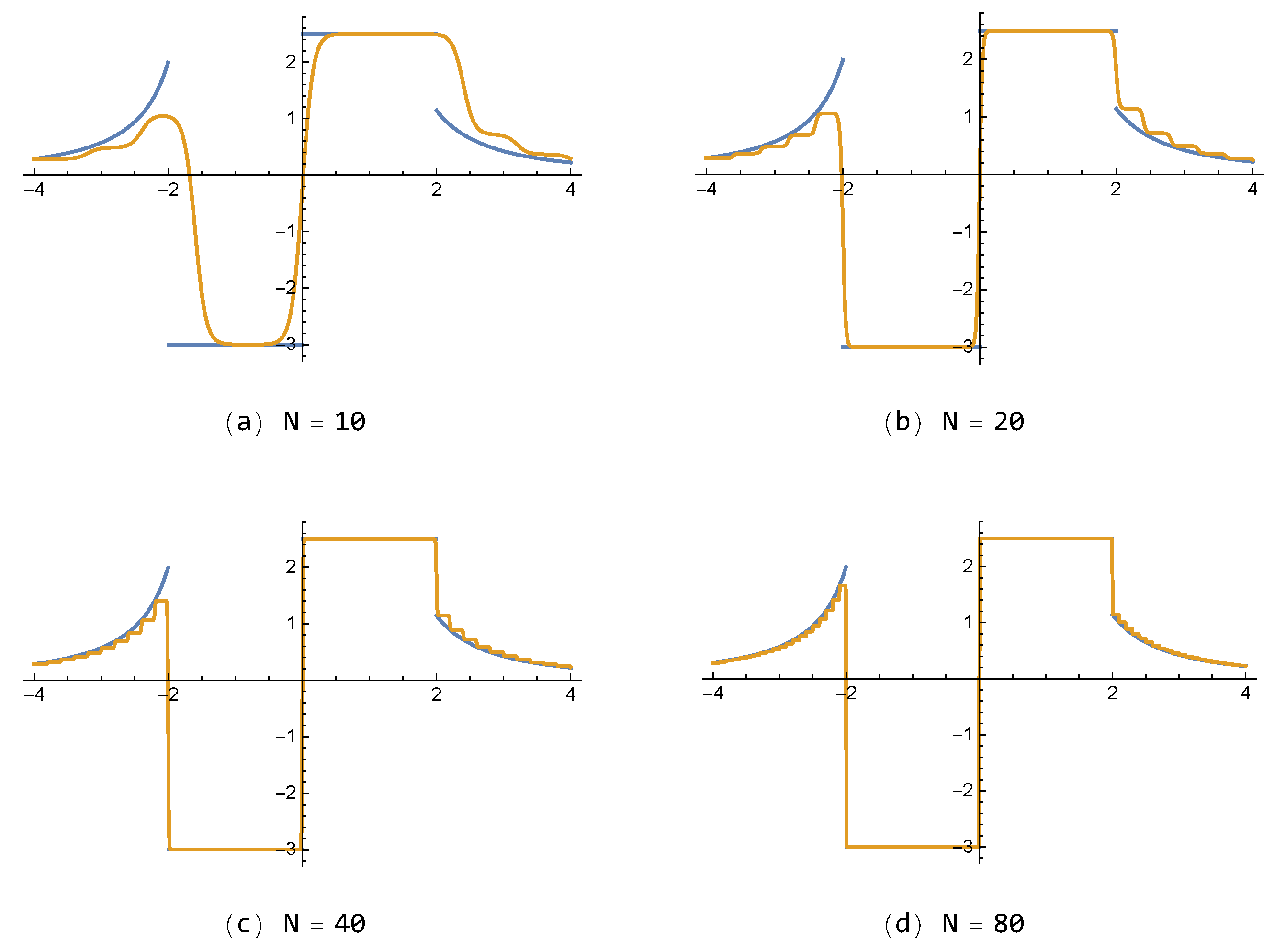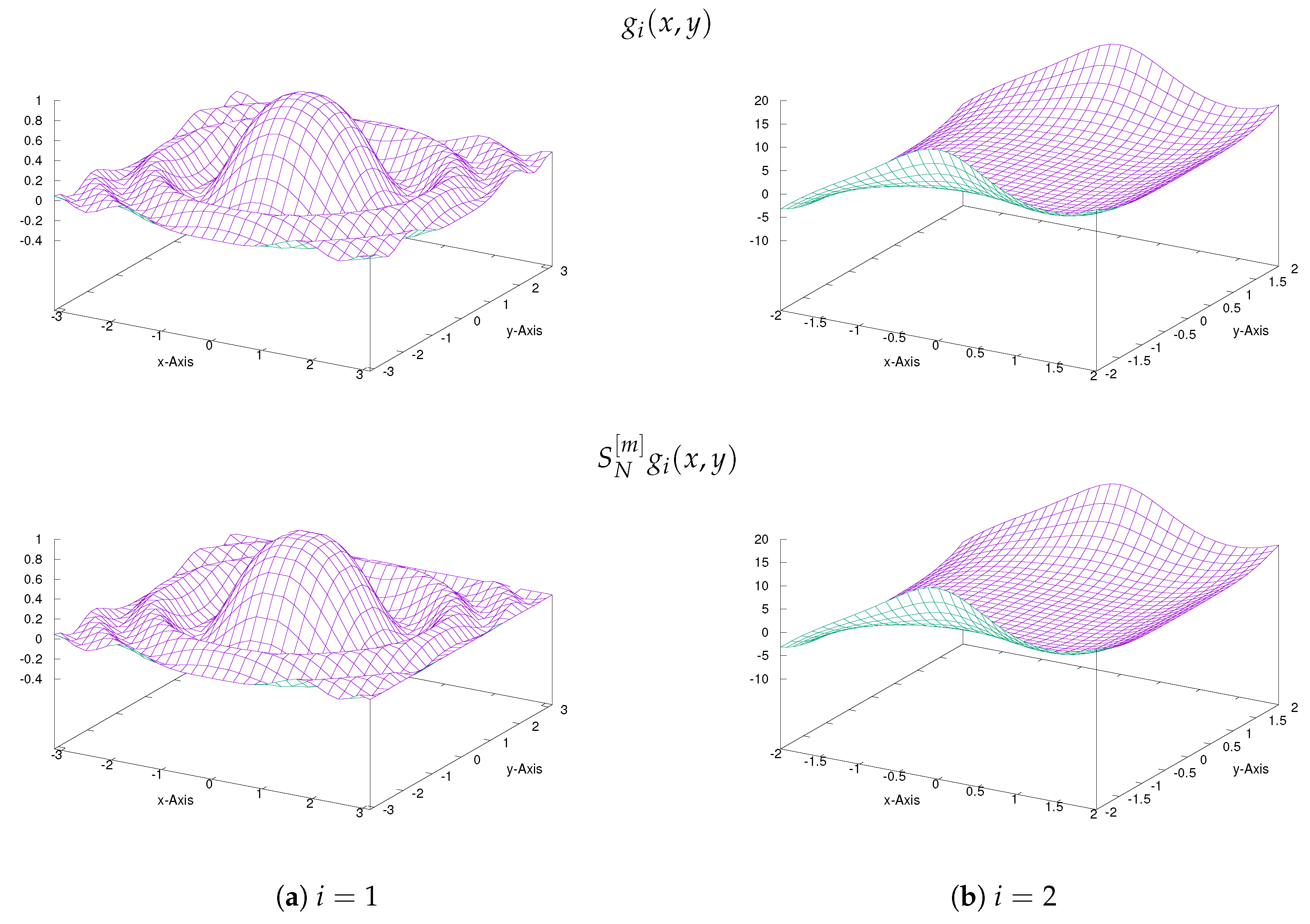1. Introduction
Cybenko [
1] and Funahashi [
2] proved that any continuous function can be uniformly approximated on a compact set
by the feed-forward neural networks (FNN) in the form of
where
is called an activation function,
are weights,
are thresholds, and
are coefficients. It is called the universal approximation theorem. Moreover, Hornik et al. [
3] showed that any measurable function can be approximated on a compact set by the form of the FNN. Some constructive approximation methods by the FNN were developed in the literature [
4,
5,
6,
7]. Other examples of the function approximation by the FNN can be found in the works of Cao et al. [
8], Chui and Li [
9], Ferrari and Stengel [
10], and Suzuki [
11]. Particularly, the activation function
is a basic architecture of the neural networks because it imports non-linear properties into the networks. This allows the artificial neural networks to learn from complicated non-linear mappings between inputs in general.
In this paper, aiming efficient approximation to the data obtained from continuous or discontinuous functions on a closed interval, we develop a feed-forward neural network approximation method based on a sigmoidal activation function. First, in the following section, we propose a parametric sigmoidal function
of the form (
6) for an activation function. In
Section 3 we construct an approximation formula
in (
19) based on the proposed sigmoidal function
. It is shown that
approximates every given data with error
,
, for the parameter
m large enough. This implies the so-called quasi-interpolation property of the presented FNN approximation. Furthermore, in order to better the interpolation errors near the end-points of the given interval, a correction formula (
27) is introduced in
Section 4. The efficiency of the presented FNN approximation is demonstrated by the numerical results for the data sets extracted from continuous and discontinuous functions. The aforementioned efficiency means that the proposed method requires less neurons to reach similar or lower error levels than the compared FNN approximation method using the conventional logistic function.
In addition, an extended FNN approximation formula for two variable functions is proposed in
Section 5 with some numerical examples showing the superiority of the presented FNN approximation method.
2. A Parametric Sigmoidal Function
The role of the activation function in the artificial neural networks is to introduce non-linearity of the input data into the output of the neural network. One of the useful activation functions commonly used in practice is the sigmoidal function
having the property below.
For example, two traditional sigmoidal functions are
We recall the following approximation theorem shown in the literature [
6].
Theorem 1. (Costarelli and Spigler [
6])
For a bounded sigmoidal function σ and a function let be a neural network approximation to f of the formfor , , and . Then for every there exists an integer and a real number such that Sigmoidal functions have been used in various applications including the artificial neural networks (See the literature [
12,
13,
14,
15,
16,
17]). In this work we employ an algebraic type sigmoidal function, containing a parameter
, as follows.
for a fixed
. This function has the following properties.
- (A1)
is strictly increasing over
and
for an integer
. In addition, referring to the literature [
12], we can see that the Hausdorff distance
d between the heaviside function
and the presented sigmoidal function
satisfies
That is, for d small enough.
- (A2)
For
m large enough
has the asymptotic behavior
where
satisfying
for all
. In addition, for any integer
- (A3)
For every
with
.
3. Constructing a Neural Network Approximation
Suppose for a real valued function
,
, a set of data
is given, where
is an integer and
are nodes on the interval
. For simplicity, we assume equally spaced nodes as
We can observe that, for sufficiently large
m, the function
with
in (
6) satisfies
due to the property (A2).
Moreover, noting that
is an increasing function as mentioned in (A1), we can see that
and from the property (A3)
To find a lower bound of the parameter
m we set
. Then we have the lower bound
, satisfying this equation, as
That is, for every
it follows that
and
The lower bound
given in (
16) will be used for a threshold of the parameter
m in the numerical implementation of the proposed neural network approximation later.
Referring to the above features of
in (
13), (
17) and (
18), we propose a superposition of
to approximate the given data
as follows.
where
.
We can see that interpolates at nodes, approximately, as implied in the following theorem. Thus we call a quasi-interpolation of .
Theorem 2. The FNN with m large enough as defined in satisfiesfor some , and a constant . Moreover,for some , and constants . Proof. Since
is an increasing function and it satisfies the asymptotic behaviour in (
8), for each
with
m large enough, we have
The second equation above results from the relation
based on the property (A3). Denoting by
and
the first and the second forward difference operators, respectively, and using the function
defined in (9), we have
Since
for some
, setting
, we have the formula (
20).
On the other hand, for
and
m large enough
Since
for some
, we have
for a constant
. For
and
m large enough
Since
for some
, we have
for a constant
. Thus the proof is completed. □
Theorem 2 implies that, for N fixed(i.e., h fixed), approximation errors of at every nodes can be accelerated by increasing the value of the parameter m.
The sum
in (
19) can be written by
Using a function
defined as
with
, satisfying
for all
t, we may rewrite
by
for
. In fact, it follows that
The formula (
23) is a form of the feed-forward neural networks based on the activation function
with constant weights
and thresholds
.
Under the assumption that
m is large enough, the proposed quasi-interpolation
in (
23) has the following properties:
- (B1)
Since
and
over the interval
, it follows that
- (B2)
For each
,
and
Graphs of the activation functions,
and
shown in
Figure 1 illustrate the intuition of the construction of the presented quasi-interpolation
. In addition,
Figure 2 includes the graphs of
with respect to the values
, which shows that
becomes flatter near the node
and far from the node as the parameter
m goes higher.
It is well known that the interpolants for continuous functions are guaranteed to be good if and only if the
Lebesgue constants are small [
15]. Regarding the formula (
25) as an interpolation with equispaced points
, its Lebesgue function satisfies
for all
x, and thus the corresponding Lebesgue constant becomes
. Noting that for the polynomial interpolation, the Lebesgue constant grows exponentially such as
as
, we may expect that
will be better than the polynomial interpolation in approximation to any continuous function, at least.
4. Correction Formula
In order to improve the interpolation errors near the end-points of the given interval, that is, to make the formula (
20) in Theorem 2 hold for all
, we employ two values at the points
and
defined as
Using these additional data, we define a correction formula of (
23) as
To explore the availability of the proposed approximation method (
27), we consider the following examples which were employed in the literature [
6].
Example 1. A smooth function on the interval . Example 2. A function with jump-discontinuities. We compare the results of the presented method with those of the existing neural network approximation method (
5) using the activation function
in (
4). In the literature [
6], it was proved that Theorem 1 holds if the weight
is chosen such as
In practice, we have used
in implementation of the existing FNN
in (
5) for the examples above. The high level software,
Mathematica(V.10) has been used as a programming tool throughout the numerical performance for the examples.
For the smooth function
in Example 1, approximations of the proposed FNN
, with small number of neurons (
) are shown in
Figure 3 with respect to each parameter
. The higher the value of
m is, the more clearly
reveals the so-called quasi-interpolation property as shown in Theorem 2. Moreover,
Figure 4 shows errors of
with
, for
the lower bound of
m as given in (
16), compared with errors of
for
. Therein the errors are defined as
and
. The figure illustrates that the presented FNN is superior to the existing FNN
for continuous test function
.
For the discontinuous function
in Example 2, approximations of the proposed FNN
, with small number of neurons (
), are shown in
Figure 5 with respect to each
. In addition, approximations of
for various values
, with
, are also given in
Figure 6. One can see that the results of the presented method
are better than those of
shown in
Figure 7. On the other hand, it is noted that the FNN approximations are free from the so-called Gibbs phenomenon, generating wiggles (i.e., overshoots and undershoots) near the jump-discontinuity, which appears inevitably in partial sum approximations composed of the polynomial or trigonometric base functions in general.
5. Multivariate Approximation
For simplicity we consider a function of two variables
on a region
, and assume that a set of data
is given for the nodes
where
,
. Set activation functions
for
, where
,
and
is the parametric sigmoidal function in (
6). Then, referring to the formula (
25) under the assumption that
m is large enough, we define an extended version of the FNN approximation to
g as
To testify the efficiency of the presented method (
31), we choose functions of two variables below. In the numerical implementation for the examples the software,
gnuplot(V.5) was used as it is rather fast for evaluating and graphing on two dimensional region.
Figure 8 shows the approximations of the presented method
to the test functions
,
, for
with
. We can see that
approximates
properly over the whole region, while the existing method
given in the literature [
6] produces considerable errors as shown in
Figure 9.
